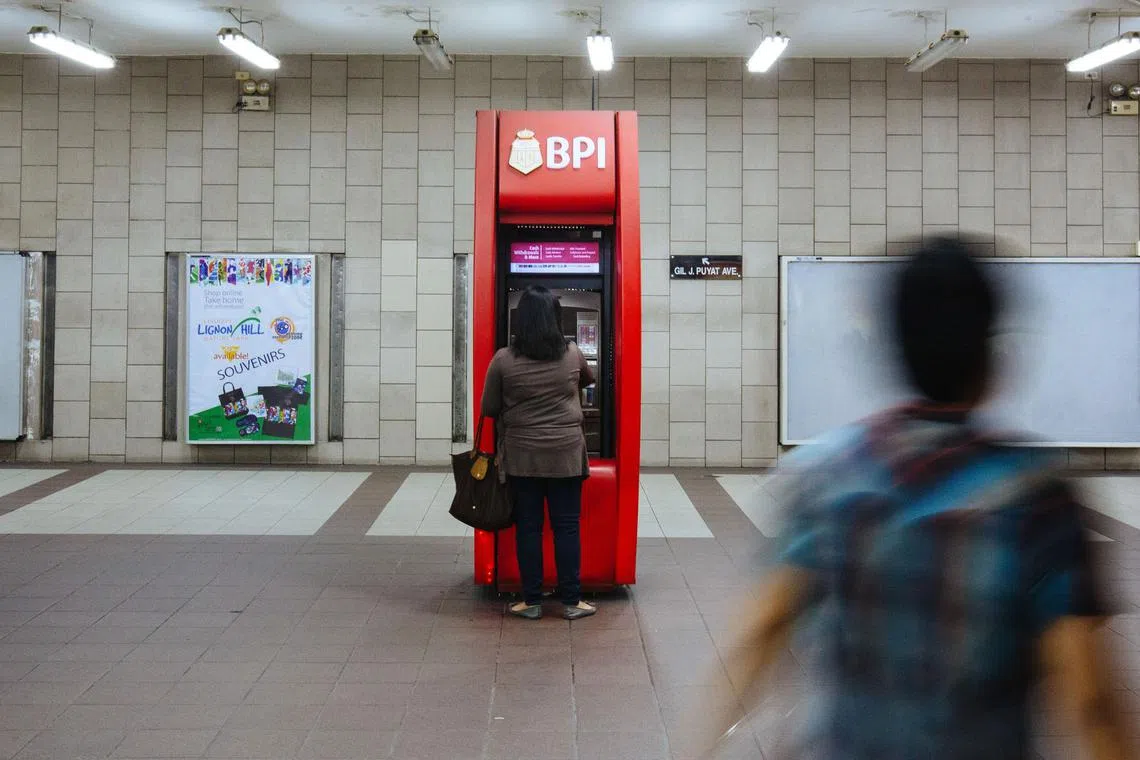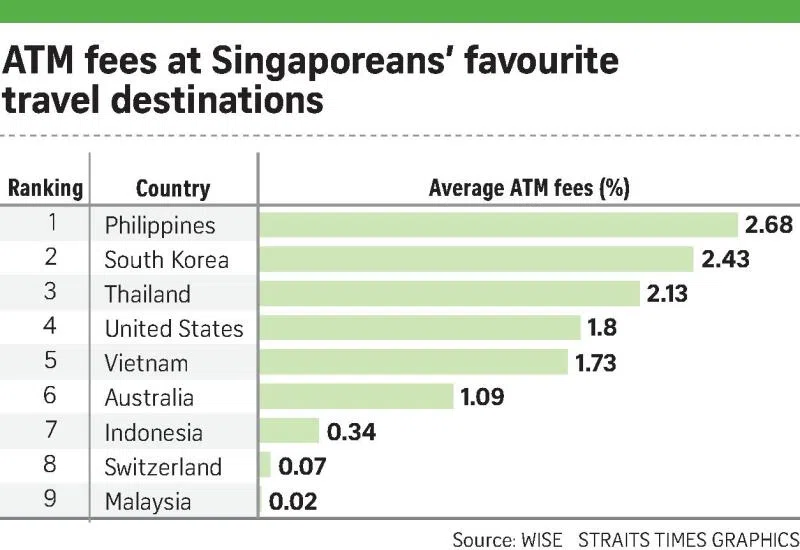Philippines, South Korea among most expensive countries for travellers to withdraw from ATM
Sign up now: Get ST's newsletters delivered to your inbox

ATM fees in these countries range from 2.43 per cent to 2.68 per cent, said Wise.
PHOTO: BLOOMBERG
Follow topic:
SINGAPORE – The Philippines, South Korea and Thailand are the most expensive countries for travellers to withdraw cash at ATMs, according to fresh data from fintech giant Wise released on Tuesday.
Average ATM fees in these countries range from 2.13 per cent to 2.68 per cent, said Wise, which ranked ATM fees at Singaporeans’ favourite destinations.
However, travellers should not worry too much as they do not need to rely solely on cash. Various payment modes such as multi-currency e-wallets and cards have sprung up in recent years, offering greater flexibility to holiday-goers.
Ms Lim Paik Wan, expansion lead for Asia-Pacific at Wise, said it is important to be aware of hidden costs when withdrawing cash overseas.
These costs often include foreign transaction fees and undisclosed mark-ups on exchange rates.
“Unassumingly small fees can add up. To put this in perspective, if someone withdrew $150 per day for a week in the Philippines, totalling $1,050, they’d pay the equivalent of $28.14 in fees,” she added.
Mr Atul Garg, principal founder and chief executive of cross-border payments company SingX, told The Straits Times earlier this year that the costs of ATM card withdrawals can go up to 3 per cent to 10 per cent
There are three types of charges – by the ATM, the traveller’s card issuer, and a hidden foreign exchange mark-up.
He advised travellers to withdraw one large amount instead of several small amounts, and tap their bank’s overseas ATM networks to avoid fees.
Wise’s data showed that Malaysia, Switzerland and Indonesia are the cheapest countries for travellers to withdraw cash, with average ATM fees ranging from 0.02 per cent to 0.34 per cent.
The numbers are based on 3.8 million cash withdrawals made with a Wise card at third-party ATMs from September 2021 to August 2022.
Wise said travellers should check the fees charged by their card providers, some of whom offer free ATM withdrawals abroad up to a certain threshold.
“To save money, either exchange money before you travel or bring a multi-currency card to withdraw cash once you arrive. If there are several ATMs (overseas) within a short distance of each other, it may be worth comparing their rates, as fees will vary from bank to bank,” said Wise.
For example, travellers can use the Wise multi-currency debit card to withdraw money at ATMs worldwide for free twice a month for amounts less than $350.
Subsequent withdrawals are charged at $1.50 per transaction, and users will also be charged an additional 1.75 per cent if they take out more than $350 in a month.
Wise added that travellers should never withdraw money on a credit card as this involves high fees and interest.
Travellers should also select the local currency when asked how they want to “pay” when withdrawing money at the machine, it added. Otherwise, they will be charged a dynamic currency conversion fee – usually 1 per cent – if they choose to pay in Singapore dollars.
Cash is just one way for travellers to pay overseas. They can also use a multi-currency account linked to a card to avoid fees while enjoying the convenience of paying with plastic. Multi-currency accounts – offered by players such as Wise, Revolut and YouTrip – let customers change Singdollars into foreign currencies while being able to view the exchange rate.
When they spend overseas, the amount is deducted directly from the foreign currency balance – for example, US dollars or euros – without incurring fees.
Ms Jacquelyn Tan, head of group personal financial services at UOB, said the bank’s customers can link their Mighty FX multi-currency account to a UOB Singdollar base account to earn additional perks associated with the latter.
Credit cards, which allow customers to earn rewards such as air miles, are another option.
But travellers should be mindful of the foreign transaction fee – usually over 3 per cent of the converted Singdollar amount – when they pay in other currencies.
There is also a foreign exchange mark-up of 3 per cent to 5 per cent, depending on the foreign currency.
Ms Tan said cardholders should pay in the local currency when they are overseas as this allows them to earn more rewards compared with paying in Singdollars.
For example, UOB PRVI miles cardholders earn 1.4 miles per S$1 spent, versus 2.4 miles when they pay the equivalent amount in the local currency.

ST GRAPHICS: TANG WEE CHEOW


